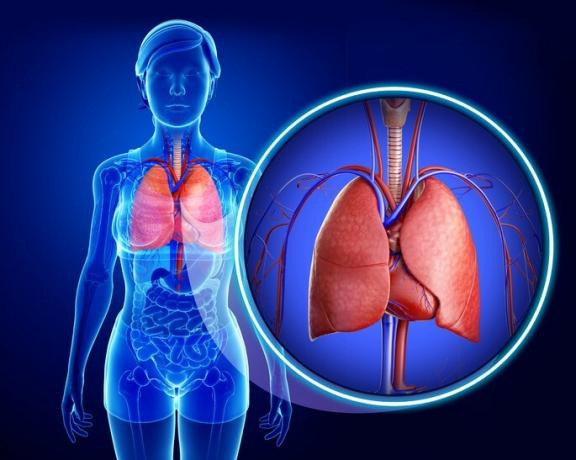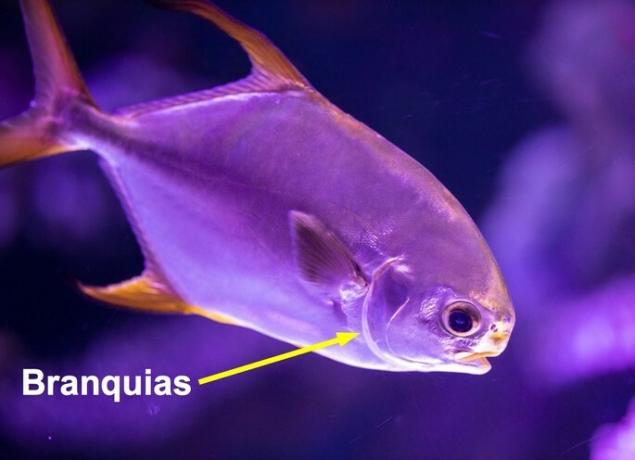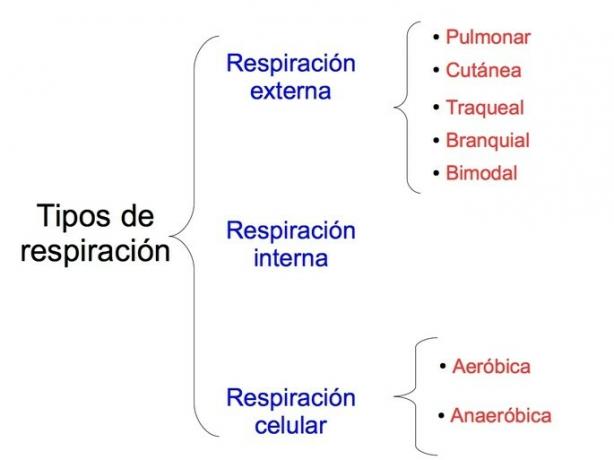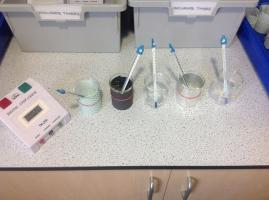Types of respiration: what are they and how many are there
Respiration is the biological process carried out by all living things that use gases for energy. In general, respiration provides oxygen to cells and removes carbon dioxide that is produced inside them.
There are different types of respiration depending on how living beings take in oxygen, how it reaches the cells and how the cell gets energy from that oxygen.
External breathing
External respiration is the exchange of gases between animals and the environment. All animals, from worms to mammals, need a mechanism that can provide oxygen for their bodies to function.
External respiration can be of different types depending on the organs involved in capturing oxygen from the environment.
Lung breathing

Pulmonary respiration, also called pulmonary ventilation, refers to the entry and exit of air through the airways to the lungs. It occurs in all mammalian animals, such as humans and rabbits, in birds, reptiles, and adult amphibians.
The lungs are the organs where the oxygen in the air is exchanged for carbon dioxide produced by cellular metabolism.
Pulmonary respiration comprises two processes: inspiration and expiration. Inspiration is when air enters and passes through the nose, windpipe, and bronchi until it reaches the lungs. Expiration is when the carbon dioxide contained in the lungs is expelled to the outside.
You may also be interested in seeing Breathing, inspiration and expiration.
Skin respiration
Integumentary or cutaneous respiration is carried out by the superficial layer that surrounds the animal, which would become its skin. This is how toads, salamanders, starfish, and earthworms take in oxygen.
The worms have capillary networks under the integument from where the exchange of gases takes place with the air spaces between the soil particles.
It is important in these animals to stay in humid inhabitants, so that the oxygen from the air can penetrate inside the body, while the carbon dioxide leaves.
Tracheal breathing

Tracheal respiration occurs through a network of tubes known as the trachea, which open on the surface of the animal. It should not be confused with the trachea of the human respiratory system.
The trachea opens to the outside of the body through spiracles, which usually have some closure device to prevent water loss.
Animals that breathe this way are insects, mites, spiders, ticks, and centipedes.
Branchial breathing

Gill respiration is the way fish take in dissolved oxygen in the water and expel carbon dioxide. This occurs in the gills, a structure found on the fish's head. Shrimp, lobsters and other crustaceans also breathe through gills.
When the fish opens its mouth, the gill cap opens, letting the water in. Oxygen from the water diffuses into the capillaries of the gills, at the same time that carbon dioxide diffuses from the blood into the water.
Amphibian larvae and some adult amphibians breathe using gills.
Bimodal breathing
Bimodal respiration is the ability of an organism to exchange gases simultaneously from air or water. A bimodal organism such as salamanders, crabs, barnacles, clams, mussels, and lungfish use their gills to breathe in water and lungs to breathe air.
Bimodal respiration was a key adaptation to enable the transition from aquatic life to terrestrial habitats.
Internal breathing

Internal or tissue respiration is the exchange of gases that occurs inside organisms. This process occurs in multicellular organisms and is produced by diffusion of gases through liquids between cells or linked to carrier molecules.
Oxygen, which is obtained through external respiration, is transported internally together with organic compounds called respiratory pigments. These pigments have copper or iron that serve to bind oxygen. The four respiratory pigments are: hemoglobin, hemocyanin, hemeritrin and chlorocruorin
Cellular respiration
Cellular respiration is the process by which cells obtain their energy from organic compounds, such as glucose. Cells need energy to carry out their activities. This energy is stored in a molecule known as ATP or adenosine triphosphate.
Cellular respiration takes place in both eukaryotic and prokaryotic cells. Depending on the ATP production process, cellular respiration can be aerobic or anaerobic.
Aerobic respiration

It is cellular respiration where oxygen is used to metabolize sugar. The result is water, carbon dioxide, and ATP. Animals and plants perform aerobic respiration in mitochondria. In prokaryotic cells it occurs in the plasma membrane.
If there is oxygen in a cell, glucose can release a much greater amount of energy than in cellular respiration without oxygen.
Anaerobic respiration
In anaerobic respiration, the breakdown of sugar occurs without using oxygen. This is useful for beings that live in environments with low oxygen content or when the cell depletes its oxygen level and needs ATP quickly.
In humans and animals, glucose is transformed into lactic acid. In yeasts and plants, glucose is transformed into ethanol and carbon dioxide.
In some bacteria or archaea, the result of anaerobic respiration depends on the compound used. For example, if the acceptor is sulfate, hydrogen sulfur is formed; if the acceptor is carbon dioxide, methane is formed.
You may also be interested in seeing Animal and plant cell.
Human respiration
Human external respiration is of the pulmonary type through the respiratory system, which is responsible for introducing oxygen into the lungs and expelling carbon dioxide.
Human internal respiration is supported by the circulatory system and the blood. Red blood cells are the cells in charge of transporting the oxygen captured in the lungs and distributing it throughout all tissues. By releasing oxygen, red blood cells pick up carbon dioxide to release it in external respiration.
Aerobic cellular respiration predominates in humans, where glucose produces between 36 and 38 ATP molecules in the mitochondria.
Sometimes we humans have to resort to anaerobic cellular respiration in our muscles. For example, when you want to do a strenuous exercise like lifting weights or running very fast, anaerobic respiration supplies ATP quickly and immediately. However, this only works for a very short time, because lactic acid builds up in the process.
Breathing in plants

Plants also carry out respiration, absorbing oxygen from the air and releasing carbon dioxide into the environment. In this case, respiration would be the reverse process of photosynthesis. This allows them to obtain energy when sunlight is not available, or during winter.
Respiration in plants is also important for obtaining building blocks of other molecules from glucose. The seeds also obtain their energy by respiration, anaerobic or aerobic depending on the availability of oxygen.
Oxygen and carbon dioxide enter or leave the leaves through the stomata. These structures form pores on the surface of the reverse side of the leaves.
You may also be interested in seeing photosynthesis and respiration.
References
Allot, A., Mindorff, D., Azcue, J. (2015) Biology. Oxford University Press.
Mauseth, J.D. (2017) Botany An Introduction to plant biology. 6th ed. Jones & Bartlett learning. Burlington, MA.
Miller, S.A., Harley, J.P. (2001) Zoology. 5th ed. McGraw-Hill.




